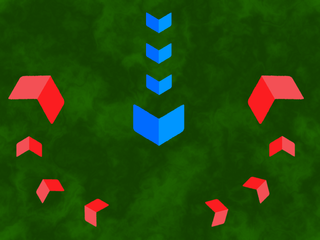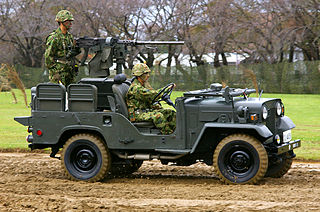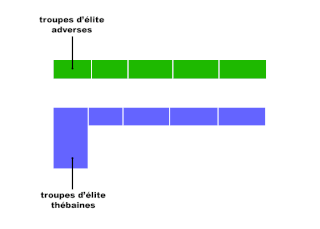Related Research Articles

The pincer movement, or double envelopment, is a military maneuver in which forces simultaneously attack both flanks (sides) of an enemy formation. This classic maneuver is important throughout the history of warfare.
A frontal assault is a military tactic which involves a direct, full-force attack on the front line of an enemy force, rather than to the flanks or rear of the enemy. It allows for a quick and decisive victory, but at the cost of subjecting the attackers to the maximum defensive power of the enemy; this can make frontal assaults costly even if successful, and often disastrously costly if unsuccessful. It may be used as a last resort when time, terrain, limited command control, or low troop quality do not allow for any battlefield flexibility. The risks of a frontal assault can be mitigated by the use of heavy supporting fire, diversionary attacks, the use of cover, or infiltration tactics.

Hit-and-run tactics are a tactical doctrine of using short surprise attacks, withdrawing before the enemy can respond in force, and constantly maneuvering to avoid full engagement with the enemy. The purpose is not to decisively defeat the enemy or capture territory but to weaken enemy forces over time through raids, harassment, and skirmishing and limiting risk to friendly forces. Such tactics can also expose enemy defensive weaknesses and achieve a psychological effect on the enemy's morale.

A pocket is a group of combat forces that have been isolated by opposing forces from their logistical base and other friendly forces. In mobile warfare, such as blitzkrieg, salients were more likely to be cut off into pockets, which became the focus of battles of annihilation.

A counterattack is a tactic employed in response to an attack, with the term originating in "war games". The general objective is to negate or thwart the advantage gained by the enemy during attack, while the specific objectives typically seek to regain lost ground or destroy the attacking enemy.
Maneuver warfare, or manoeuvre warfare, is a military strategy which seeks to shatter the enemy's overall cohesion and will to fight.

Encirclement is a military term for the situation when a force or target is isolated and surrounded by enemy forces. The situation is highly dangerous for the encircled force. At the strategic level, it cannot receive supplies or reinforcements, and on the tactical level, the units in the force can be subject to an attack from several sides. Lastly, since the force cannot retreat, unless it is relieved or can break out, it must fight to the death or surrender.
Annihilation is a military strategy in which an attacking army seeks to entirely destroy the military capacity of the opposing army. This strategy can be executed in a single planned pivotal battle, called a "battle of annihilation". A successful battle of annihilation is accomplished through the use of tactical surprise, application of overwhelming force at a key point, or other tactics performed immediately before or during the battle.

A breakout is a military operation to end a situation of investment by offensive operations that achieve a breakthrough—escape from offensive confinement. It is used in contexts such as this: "The British breakout attempt from Normandy". It is one of four possible outcomes of investment, the others being relief, surrender, or reduction.
Defeat in detail, or divide and conquer, is a military tactic of bringing a large portion of one's own force to bear on small enemy units in sequence, rather than engaging the bulk of the enemy force all at once. This exposes one's own units to many small risks but allows for the eventual destruction of an entire enemy force.
Deep operation, also known as Soviet Deep Battle, was a military theory developed by the Soviet Union for its armed forces during the 1920s and 1930s. It was a tenet that emphasized destroying, suppressing or disorganizing enemy forces not only at the line of contact but also throughout the depth of the battlefield.

The oblique order is a military tactic whereby an attacking army focuses its forces to attack a single enemy flank. The force commander concentrates the majority of their strength on one flank and uses the remainder to fix the enemy line. This allows a commander with weaker or equal forces to achieve a local superiority in numbers. The commander can then try to defeat the enemy in detail. It has been used by numerous successful generals. Oblique order required disciplined troops able to execute complex maneuvers in varied circumstances.

Fire and movement, or fire and maneuver, is the basic modern military low-level unit tactic used to maneuver on the battlefield in the presence of the enemy, especially when under fire. It involves heavy use of all available cover, and highly-coordinated exchanges of rapid movement by some elements of the squad or platoon while other elements cover this movement with suppression fire. It is used both to advance on enemy positions as part of an attack, or withdrawal from current positions under attack by the enemy. The moving and supporting (suppressing) elements may be teams or individuals, and may quickly and continuously exchange roles until the entire unit completes the maneuver objective. Some members will specialize more in different roles within fire and movement as fits their range, equipment, terrain, and ability to maneuver. This is usually applied to standard infantry tactics, but forms of this are also used with armored fighting vehicles or when supported by artillery or airpower.

In military tactics, a flanking maneuver is a movement of an armed force around an enemy force's side, or flank, to achieve an advantageous position over it. Flanking is useful because a force's fighting strength is typically concentrated in its front, therefore, to circumvent an opposing force's front and attack its flank is to concentrate one's own offense in the area where the enemy is least able to concentrate defense.

The strategy of the Roman military contains its grand strategy, operational strategy and, on a small scale, its military tactics. If a fourth rung of "engagement" is added, then the whole can be seen as a ladder, with each level from the foot upwards representing a decreasing concentration on military engagement. Whereas the purest form of tactics or engagement are those free of political imperative, the purest form of political policy does not involve military engagement. Strategy as a whole is the connection between political policy and the use of force to achieve it.
The hammer and anvil is a military tactic involving the use of two primary forces, one to pin down an enemy, and the other to smash or defeat the opponent with an encirclement maneuver. It may involve a frontal assault by one part of the force, playing a slower-moving or more static role. The second phase involves a more mobile force that maneuvers around the enemy and attacks from behind or the flank to deliver a decisive blow. The "hammer and anvil" tactic is fundamentally a single envelopment, and is to be distinguished from a simple encirclement where one group simply keeps an enemy occupied, while a flanking force delivers the coup de grace. The strongest expression of the concept is where both echelons are sufficient in themselves to strike a decisive blow. The "anvil" echelon here is not a mere diversionary gambit, but a substantial body that hits the enemy hard to pin him down and grind away his strength. The "hammer" or maneuver element succeeds because the anvil force materially or substantially weakens the enemy, preventing him from adjusting to the threat in his flank or rear. Other variants of the concept allow for an enemy to be held fast by a substantial blocking or holding force, while a strong echelon, or hammer, delivers the decisive blow. In all scenarios, both the hammer and anvil elements are substantial entities that can cause significant material damage to opponents, as opposed to light diversionary, or small scale holding units.
An armoured spearhead is a formation of armoured fighting vehicles, mostly tanks, that form the front of an offensive thrust during a battle. The idea is to concentrate as much firepower into a small front as possible so that any defenders in front of them will be overwhelmed. As the spearhead moves forward, infantry units following in the gap behind them form up on both sides of the line of advance to protect the flanks.

In military tactics, the kill zone, also known as killing zone, is an area entirely covered by direct and effective fire, an element of ambush within which an approaching enemy force is trapped and destroyed. The objective of the ambush force is to quickly kill or capture all enemy soldiers inside the kill zone. The trapped soldiers may respond by counterattacking.
References
- 1 2 US Army, FM 3-90 (Tactics), July 2001, 3-12
- ↑ US Army, FM 3-90 (Tactics), July 2001, 3–13
- ↑ US Army, FM 3-90 (Tactics), July 2001, 3–15
- ↑ vertical envelopment, encyclopedia.com, Retrieved 2009-12-03. Quotes The Oxford Essential Dictionary of the U.S. Military.
- ↑ Chan, Eric. "Escalating Clarity without Fighting: Countering Gray Zone Warfare against Taiwan (Part 2)". globaltaiwan.org. The Global Taiwan Institute. Retrieved 21 June 2021.